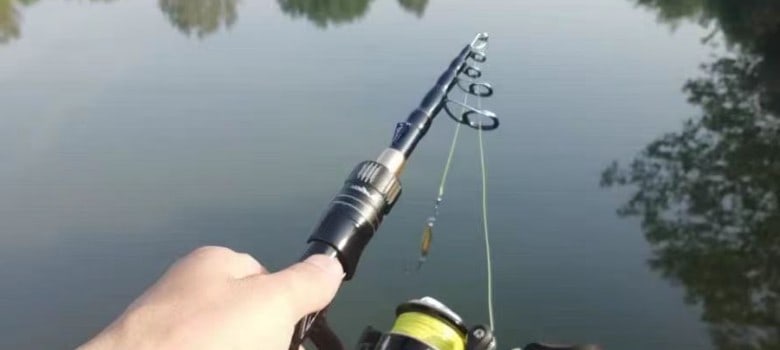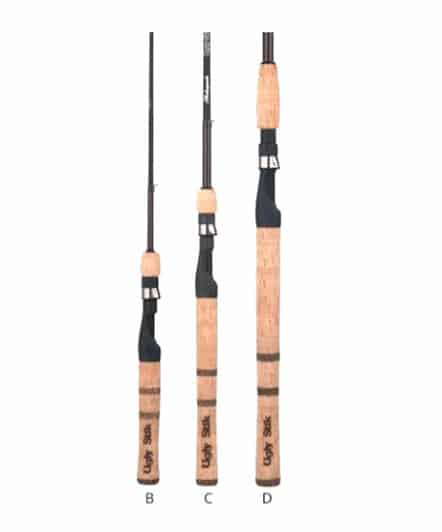If you buy via a link on this page, we may receive a commission, at no extra cost to you.Learn more
Initially, anglers were wery of telescopic fishing rods. Myself included. However, telescopic rods have aged like fine wine. They keep getting better and better.

Telescopic rods might not be as strong and reliable as a single-piece model. Still, their compact form factor is unmatched. As a result, they are the ideal option for anglers on the go or with little space inside their homes.
But to choose right, you need to know what to look for. That’s why we will compare carbon fiber and fiberglass telescopic rods today. We will discuss price, pros, cons, weight, availability, and more! So stay tuned to get the best value for your money.
Carbon Fiber Versus Fiberglass: What’s the Difference
To understand the difference between carbon fiber and fiberglass telescopic rods, you must first understand why both materials are different.
In a nutshell, fiberglass is a reinforced plastic matrix. In this case, the matrix is fortified with fiberglass. The fiberglass can be flattened into a glass sheet and then woven into the matrix, as happens with fiberglass rods. Flexibility and price are the two main advantages of fiberglass.
On the other hand, carbon fiber comprises thousands of carbon atoms bonded together at high temperatures. The process is more technical than this, of course. However, I don’t wish to bother you with the details.
Like fiberglass, carbon fiber has many uses such as bike frames to fishing rods and reels.
Carbon Fiber Telescopic Fishing Rods
Most telescopic rods I’ve tested feature a carbon fiber construction. Some others offer composite cores. We will explain that later.
Carbon fiber telescopic rods are lighter and stronger than fiberglass models. In other words, it takes fewer carbon shards to match the strength of fiberglass. Consequently, the resulting product is also lighter.
Because portability and lightweight are the two main advantages of telescopic fishing rods, carbon fiber models are quite common. Plus, they are more sensible too.
However, carbon fiber is delicate, stiff, and pricy. Therefore, you should take good care of your equipment to keep it pristine. As a result, I do not recommend getting one if you want a backpacking fishing rod to use during your camping trips.
On the other hand, carbon fiber rods are typically more expensive. They might be suitable for anglers with a tight budget, as a result.
What High Modulus Graphite Means?
You might have noticed that some carbon fiber rods have a high modulus rating. In simple terms, the modulus measures how much pressure you need to break the fiber.
There are five carbon fiber modules, with ultra-high modulus being the strongest. Most carbon fiber telescopic rods out there are high-modulus carbon fiber.
Keep in mind that even though two rods have the same modules, they might be equally strong. Why? All carbon fiber matrices between 350-450 gPa are high modulus. It is a big gap, as you can see.
Is Carbon Fiber and Graphite the Same Thing?
Although some people refer to graphite as something different. In essence, they are the same thing.
I don’t wish to get too technical on this. Believe me. I can. The key takeaway here is that graphite is a type of carbon fiber. It is commonly made with petroleum pitch and is almost pure carbon shards.
Either way, to the effect of fishing rods, both are the same.
Fiberglass Telescopic Fishing Rods
The Eagle Claw and Hurricane MK are two examples of fiberglass telescopic rods. These also happen to be the best two I’ve tested. You can check my in-depth review here.
Fiberglass telescopic rods use the fiber’s strength, flexibility, and durability. The result is a long-lasting frame with more than enough strength to pull any fish out of the water.
However, fiberglass rods, in general, are less sensitive than graphite. It might take some time for you to notice bites.
One unspoken advantage of fiberglass telescopic fishing rods is their price. They are substantially cheaper than carbon fiber variants. Consequently, they might be better for anglers who don’t wish to break the bank. Or for anglers that wish to own a durable rod.
Carbon Fiber and Fiberglass Composite Telescopic Rods
Both carbon fiber and fiberglass have desirable features. That’s why some brands decided to use both materials on their rods. Take the KastKing Blackhawk II, for example. This telescopic rod has a carbon fiber core with a fiberglass-reinforced tip.
As a result, the Blackhawk offers both sensibility and strength with a flexible tip. Some others, like the Hurricane, use full fiberglass with graphite reel seats. The results are different in this case. Let’s elaborate.
The fiberglass pole will be flexible and durable. Both are desirable features in a telescopic fishing rod to withstand constant extension and collapse. On the other hand, the graphite reel seat fill increases the sensibility.
In simple terms, using a composite blank will give you a balance between both words.
How to Take Care of a Telescopic Fishing Rod?
Although telescopic fishing rods are as reliable as full-fetch rods, they require adequate care and maintenance.
Cleaning after each use, lubricating the joints, and inspecting the line guides are some of the steps needed to get the most out of your investment.
That’s why I’ve compiled some of the steps I take to take care of my telescopic rod. You can access them here.
Carbon Fiber or Fiberglass: Which Telescopic Rod is The Best
Choosing the correct telescopic model comes down to what you need. Do you want something light and sensible without compromising durability? Then, a carbon fiber model is the best bet.
Nevertheless, if the price is a problem and durability a priority, considering a fiberglass telescopic rod is the way to go. Composite rods are also a suitable choice for either case. They are not too expensive. Plus, they hit the sweet spot between durability. flexibility, and sensitivity.
If you are thinking about getting one, I invite you to check our 10 best telescopic rods of 2023! Make sure to share with us which one you end up getting.



